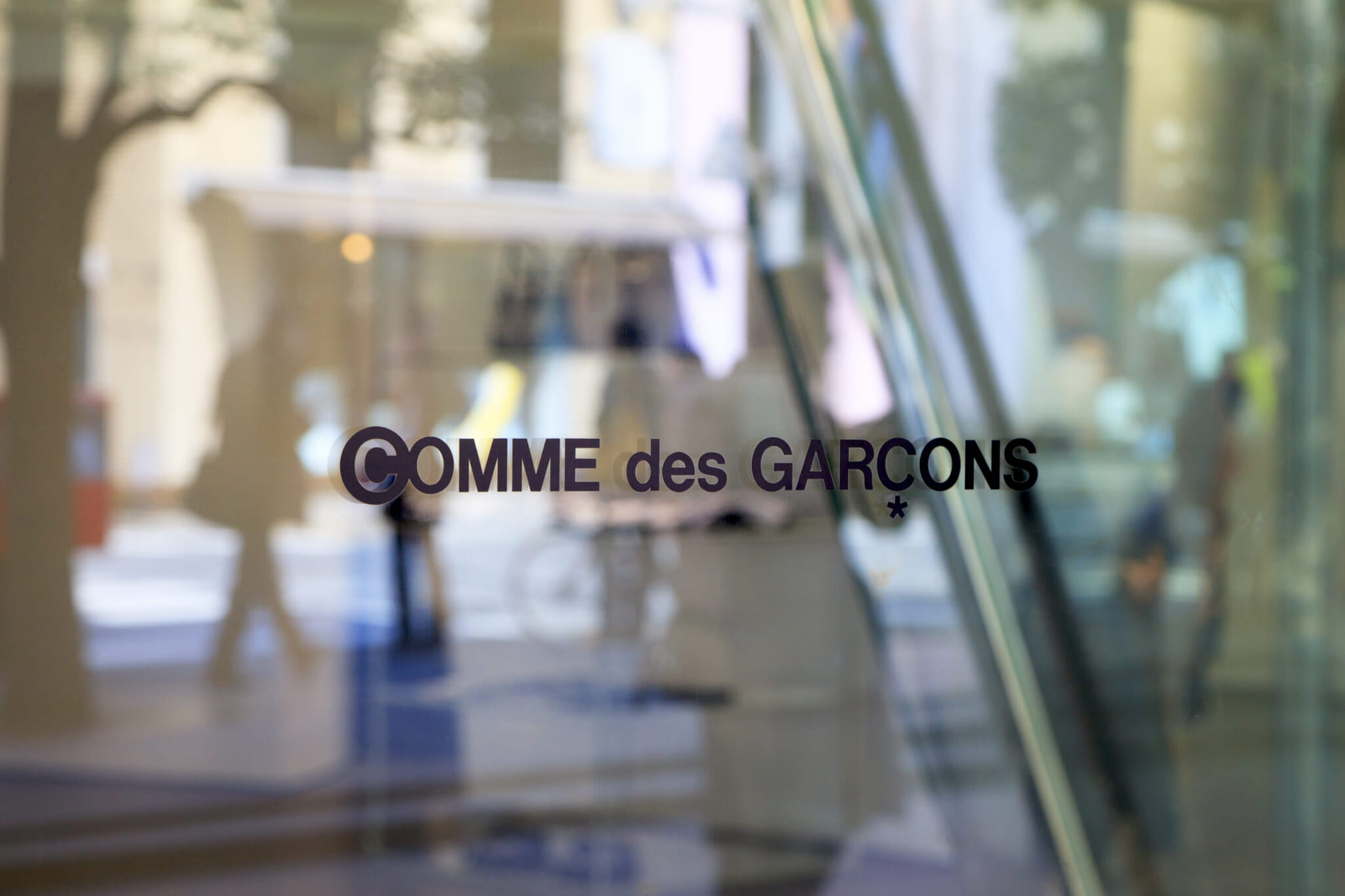There are no comparisons. There are no substitutes. Proudly standing on the peripheries of the major fashion conglomerates, including Moët Hennessy Louis Vuitton (LVMH) and Kering, Comme des Garçons has always positioned itself with a fierce independence and a reputation within the industry as a truly influential giant, a leader and an entity which inspires and renews itself with every collection.
Comme des Garçons, essentially, is a brand like no other. From its genre-defying collections, the paradigm-shifting retail stores which balance the contemporary with profound Japanese philosophies and, crucially, pioneering feminism as central to its ethos and ethics, it has been leading fashion since its registration as Comme des Garçons Co. Ltd. 50 years ago.
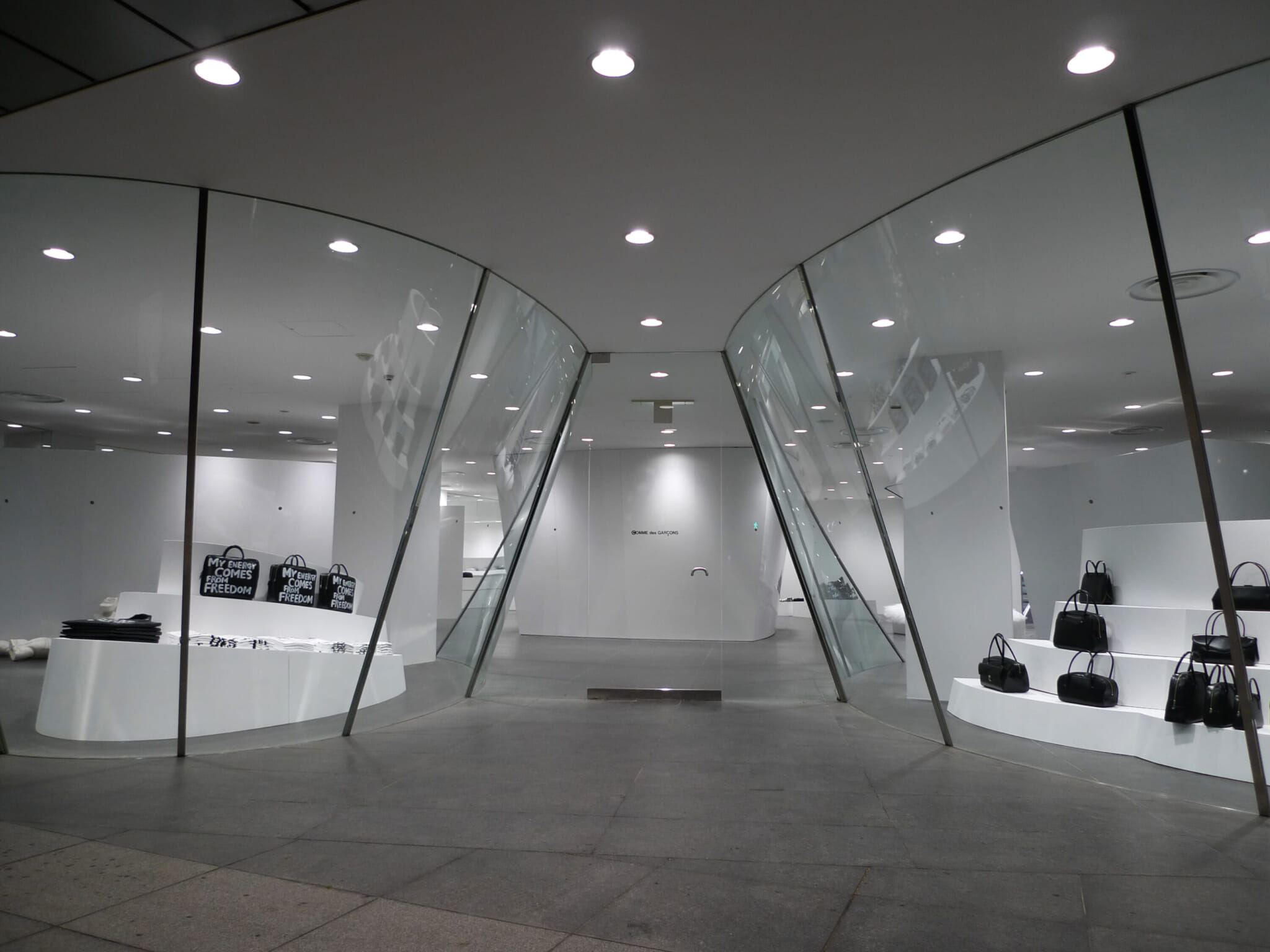
Comme des Garçons Aoyama Store
Fashion as Architecture
Established as an official company in 1973 by Rei Kawakubo (although initially started by Kawakubo in 1969), Comme des Garçons exploded onto the European and, later, global fashion scene in the early 1980s when Kawakubo showcased, in Paris, her Autumn/Winter 1982-83 collection “Holes” which was composed of sweaters and other garments torn and exposing holes and gaps. Although, it could be said that her debut in Paris in 1981, dubbed “Hiroshima chic” by critics, perhaps, put her in the sight of editors and critics.
In 2014, holes reappeared in the brand’s collaboration with Louis Vuitton with a series of handbags that deliberately positioned holes and openings. Kawakubo’s use of holes and the “gap” as an aesthetic choice has been echoed in other Japanese artistic practices, such as the facade of SANAA’s Zollverein School of Management and Design. It’s no surprise that SANAA’s Kazuyo Sejima is a well-known admirer of Kawakubo and Comme des Garçons. If you delve deeper, the architectural concepts and mind-boggling shapes that SANAA works with in its architectural and design practice are connected to a broader cultural influence led by artists such as Kawakubo.
With its architecturally experimental flagship situated in Tokyo’s Aoyama district, Comme des Garçons has gone from strength to strength with a strong retail presence the world over. The brand was also one of the early instigators of the Guerrilla store, a precursor to the now ubiquitous pop-up, in the early 2000s. Focusing on traditionally non-fashion cities, including Glasgow, Warsaw, Cologne and Reykjavík, Comme des Garçons inhabited warehouses and unorthodox spaces within cities which had, until then, been pretty much ignored or sidelined in terms of having access to innovative high fashion.
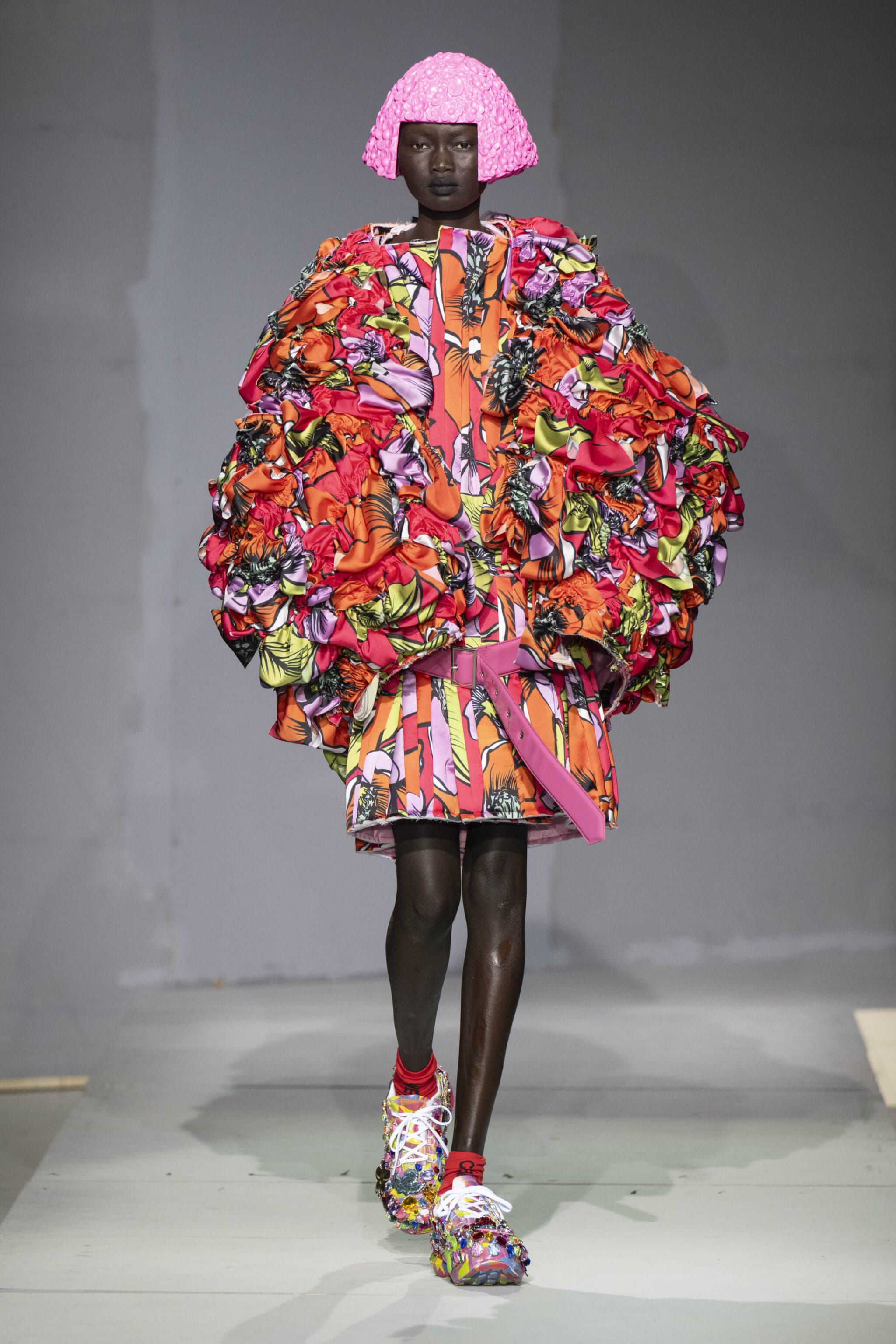
Comme des Garçons Spring/Summer 2024
The Philosophy of Zen Buddhism
Another concept central to understanding Comme des Garçons is rebirth, an idea central to Buddhism. Although Kawakubo doesn’t appear to be particularly religious, she does experiment with concepts contained within Japanese Zen, perhaps within the suburbs of her imagination.
One aspect and perhaps a fundamental part of the Comme des Garçons philosophy is, according to acclaimed curator and author Andrew Bolton, connected to the Japanese Zen concepts of ma and mu. Kawakubo, herself, never seems to probe or intellectualize her creations. A collection is made and it is then time to move on to the next. That doesn’t prevent scholars or critics, however, from pouring over and intellectualizing her art. Ma and mu are two concepts or words which reoccur when reading about Kawakubo and Comme des Garçons. Interconnected and esoteric, they perhaps clarify and compound the philosophy or philosophies of the brand itself. Ma includes an array of meanings and takes in the idea of gaps, intervals and openings. Mu, meanwhile, plays with the concept of negation and emptiness.
Rebirth can be found in each collection but also in the physical spaces of the Comme des Garçons stores where, after each season, they go through a complete transformation of design and atmosphere. This process is labeled as tachiagari or beginning. Indeed, renewal and rebirth are pretty common concepts in Japan and can be seen, prominently, in architectural structures such as temples and shrines, which are often destroyed and rebuilt after a certain amount of time. One of the most well-known examples of this is Ise Shrine in Mie Prefecture, which is torn down and rebuilt every 20 years. It could be said that the Japanese perhaps don’t read too much into original and authentic structures as objects of historic fascination. Structures of historic significance are often found to be under the threat of demolition. Nakagin Capsule Tower being one of the most notable and recent of such structures.
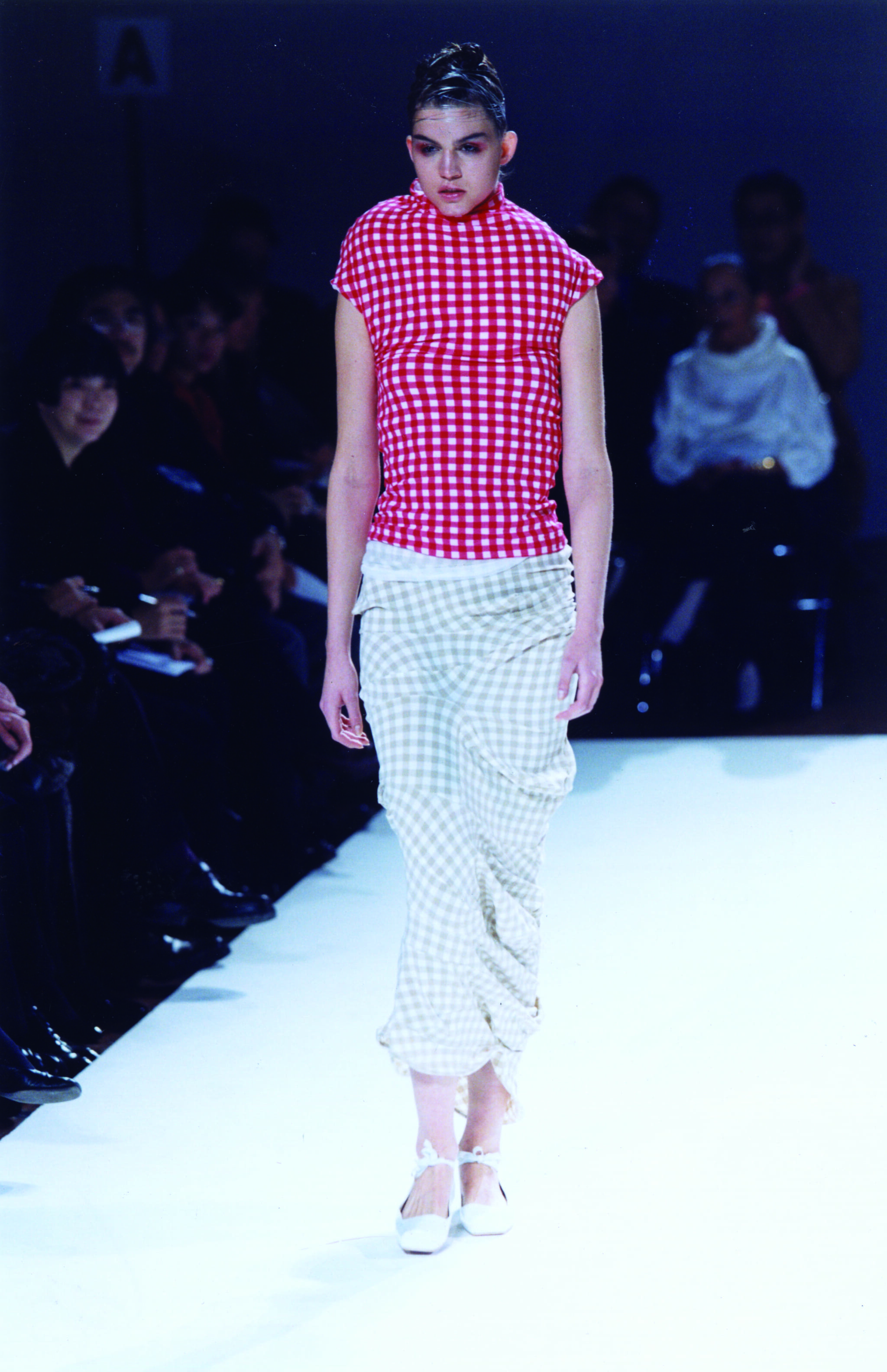
Comme des Garçons Spring/Summer 1997
Concepts of Body and Notable Collections
I first became aware of Kawakubo when I was a student in Glasgow in the 1990s studying English Literature and Theatre Studies and addicted to magazines such as The Face, Dazed and Confused, i-D, GQ and Tank. The fashion shows of Alexander McQueen for Givenchy and, later, his eponymous label and John Galliano for Dior, for me, championed fashion as theater. McQueen’s supreme and gobsmacking collections “Highland Rape” and “Voss” should be considered as masterpieces of theater, possibly more than fashion collections.
Most importantly, McQueen and Galliano looked up to Kawakubo as a mentor and a designer who challenged and ultimately rewrote how fashion is perceived in terms of performance art and creativity. McQueen, in fact, was invited to walk for the Comme des Garçons’ Homme Plus Autumn/Winter 1997 show in Paris. He also said of Kawakubo, “I think that every designer you ask will be influenced by Rei in one way or another, but what makes them a good designer is them moving the Rei concept on for their own label.”
It was probably the Comme des Garçons Spring/Summer 1998 collection which would have been in magazines the year I first came across the brand. I remember being intrigued and confused by the clothing and by the concept or lack of concept. Unorthodox shapes, threads of fabric hanging loose and the pleated columns of this collection which was named “Clustering Beauty.” This collection played on the idea of repetition and stacking, which is something that fascinated me. Repetition, palindromes and circularity seem to manufacture themselves as patterns throughout my life and are something I’m very conscious of as both philosophical and tangible constructs.
Kawakubo mentions, in regard to this particular collection, that the clothing validates and places value on the notion of imperfection. Imperfection or finding beauty in imperfection, of course, refers to the Japanese concept of wabi-sabi. Asymmetry can be just as enchanting as symmetry. Ugliness or perceived ugliness is fascinating in itself. A broken nose, a mismatching color palette, the very idea of dissonance is beautiful to me and continues to be, like an aesthetic current which flows down river from decade to decade.
It was years later, but the moment I saw Kawakubo’s collection for Spring/Summer 1997, I realized that shapes used in apparel are never actually set in stone. I also became involved in the notion that clothing can be adaptable, molded and interchangeable. The designs used for this, now legendary, collection named “Body Meets Dress, Dress Meets Body” were subsequently adapted for legendary American choreographer Merce Cunningham’s performance “Scenario.”
These costumes and clothing dance and jump, change shape and become protean and something else, as Kawakubo always intended. The so-called “lumps and bumps” that were used in this collection can be taken out or put in, depending on the mood of the wearer, with the shape and silhouette changing each time the garment is worn. This is the definition of adaptable fashion. Fashion which pushes convention and orthodoxy, rather than settling for triteness.
In some way it resembles the Japanese metabolist architecture movement from the 1970s. Architecture and design, which can be transformed and plugged, played and renewed and refreshed from time to time. Perhaps Kisho Kurokawa’s aforementioned Nakagin Capsule Tower, located in Tokyo’s Shinbashi district, was considered the most recognizable monument to metabolism. It ultimately failed as an architectural and social experiment, but its legacy remains and influences architects and designers to this day. Architectural box cubes which could be, in theory, replaced at whim.

Comme des Garçons Spring/Summer 2020
A Room of One’s Own
In some ways it’s unsurprising that the work of Virginia Woolf would end up being channeled as an integral component of Kawakubo’s work. The resulting creative triptych of projects related to and inspired by Woolf’s 1928 novel Orlando. Referred to as probably the first ever trans novel and often characterized as “gender-bending,” it illustrates Woolf’s creative and political outlook on life, which also includes stream of consciousness as a narratorial device in novels such as Mrs Dalloway, the core of feminism found in A Room of One’s Own and an anger at patriarchy and the conventions and oppression that comes with it.
So, it was of no real surprise, then, that Kawakubo would become involved in Woolf’s universe for the Comme des Garçons Homme Plus Spring/Summer 2020 show, the Spring/Summer 2020 collection for Comme des Garçons and finally designing the costumes for the Vienna State Opera’s production of Orlando composed by Olga Neuwirth.
The results are staggering. Swoon over the colors in the womenswear show, these brilliant patterns, the jacquards, brocades and those indefinable shapes. The reviewer for Vogue, the magnificent Sarah Mower, writes of the “padded pouf skirts!” which cements Kawakubo’s love for distorting and accentuating shapes. The result being that the silhouette is unorthodox, wildly eccentric and always fashion forward. By fashion forward I mean fashion which looks to the future and is born out of the contemporary and not merely recycling the past.
The menswear show, though less glamorous and gorgeous, is still a triumph. Fluid, loose, gender indifferent, these garments can be worn by any person. And that is what is so appealing about this brand. Anyone with disposable income can afford to buy into this world. It’s a world which is respectful of any gender or nonbinary, non-gender. A person who likes textiles and design. A person who loves the quick spray of an odd lingering scent before leaving the house. And a person who is changed by a jacket or pouf skirt, who becomes emboldened, confident and proud.
Kawakubo’s costume designs for Neuwirth’s production in Vienna are astounding. And that’s saying something, as anyone who has seen the costume designs for Sally Potter’s sumptuous 1992 film Orlando, starring the peerless Tilda Swinton, will testify that the designs used are some of the most astounding costume designs ever captured on film. Opulent, with an outrageous attention to detail, the costumes star through time and historical periods, mirroring the plot of Woolf’s groundbreaking work. Kawakubo’s interpretation of Orlando is on par with the film’s costumes and this project is the first time Kawakubo has directed for the stage since her work on Cunningham’s “Scenario” in the mid 90s.
I urge you to watch Potter’s film. Beautiful, delicate and in tune with Woolf’s polemic, “Different sex, same person.” Swinton is radiant throughout and plays Orlando with sensitivity, charm and a considerable amount of chutzpah, often breaking the fourth wall.
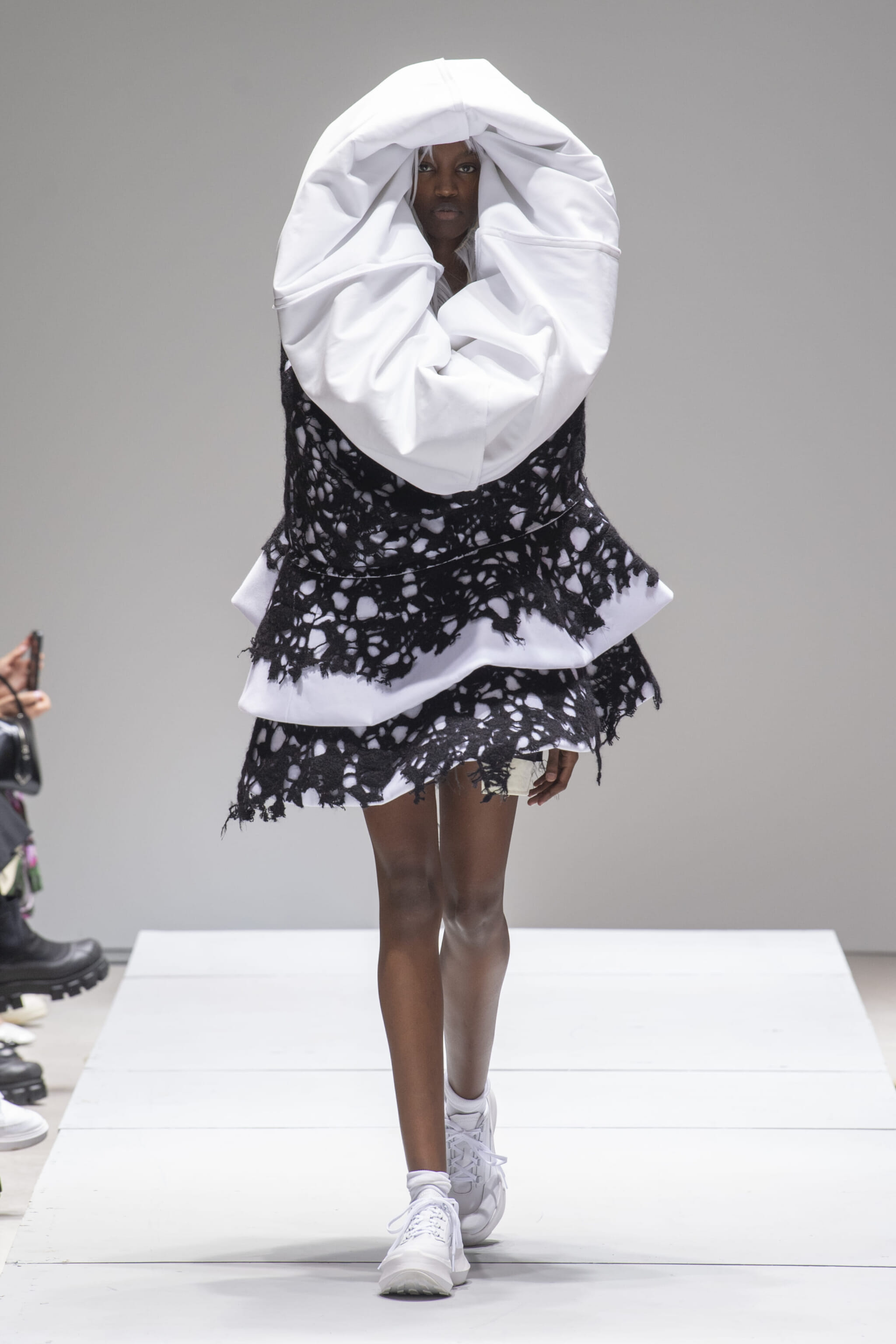
Comme des Garçons Spring/Summer 2023
Comme des Garçons and Feminism
In a country where the gender gap is clearly conspicuous, with Japan ranking 125 (out of 146 countries) in the world in 2023, Kawakubo can be seen as a shining light, a mentor and role model for young people growing up today. When Kawakubo had just begun Comme des Garçons in 1969, women in Japan were treated as second-class citizens. It could very well be argued that they are still being treated this way today. Renowned academic Bonnie English mentions that Vera Mackie, an Australian academic who specializes in Japanese feminism and gender history, highlighted the condition of women in Japan around 1970.
“Tanaka Mitsu’s article ‘Liberation from the Toilet’…which became part of the manifesto for the group Tatakau Onna (Fighting Women). This article provides ‘an impassioned condemnation of the conventions of sexual behavior whereby women [in Japan] were condemned to be ‘mothers or ‘whores.'”
When you place the history and global influence of Comme des Garçons within this social, political and historical framework, you see that Kawakubo is a pioneer. She took all the risks, engineered a mode of living, an aesthetic and ethical arrow which has traveled through time. She isn’t just an influential designer; she is the designer. Equipped with an army of similar minds, a husband who is often portrayed as her interpreter or shield from unwanted press, a particular method of creating which feels independent and low-fi in some respects but is also a global fashion powerhouse and leader in others.
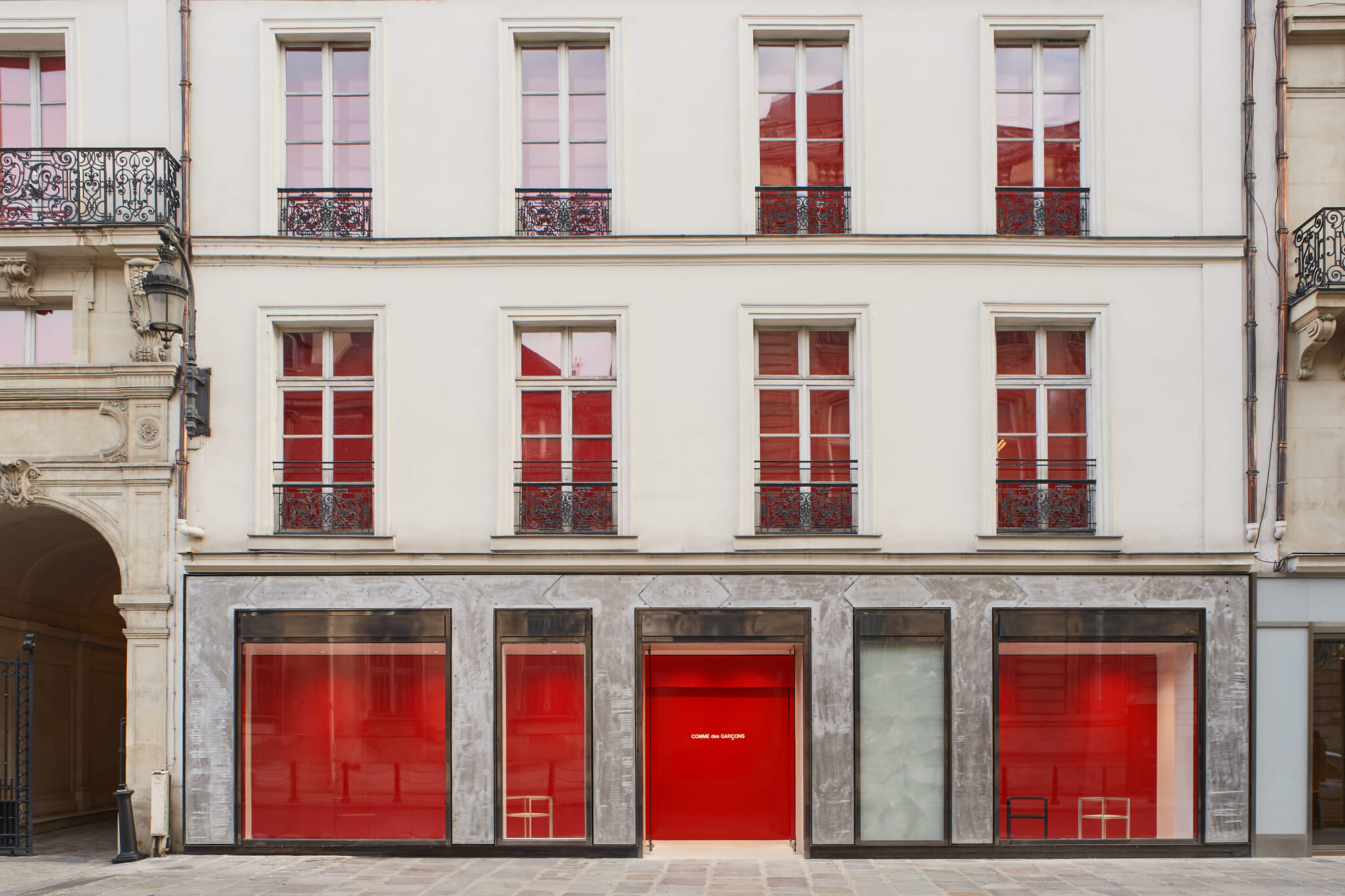
Comme des Garçons Paris Store. Photo by Adrien Dirand
Comme des Garçons at 50
There are plenty of brands which cherish and celebrate their heritage and legacy within fashion, such as Gucci, Burberry and Dior. No other fashion empire, however, replicates what Comme des Garçons accomplishes from year to year. From season to season, Kawakubo and other designers working within the brand (namely Junya Watanabe and Kei Ninomiya) fundamentally change fashion by creating within an artistic vacuum working outside conventional boundaries. Kawakubo, who often creates a collection from “nonverbal, abstract images inside of me that I try to shape into my work,” is an example of how all art should be created. Free from superficial capitalist restrictions and outside influence, the artistic susurration of Comme des Garçons can be felt in a number of disparate industries and continues to be a trailblazer and leader within global fashion and beyond.

